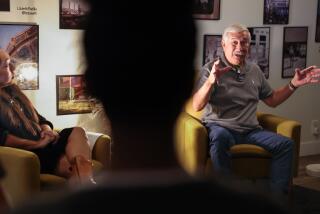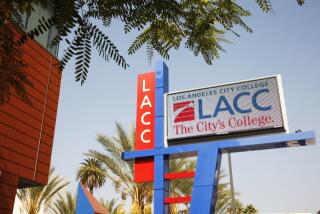U.S. Expatriate Aids Soweto Youths
SOWETO, South Africa — Not so long ago, Keneilwe Mampe would walk the seven miles to and from school because her single mother couldn’t afford the bus fare: less than 5 cents a day. With little money for lunch, the teen frequently studied on an empty stomach. Her tuition often was paid late--or not at all.
There were doubts that Keneilwe, 15, an academic award winner at Dr. Beyers Naude Secondary School in this sprawling black township outside Johannesburg, would be able to enroll this year.
And then along came Compton native Jose Bright, offering to pay for Keneilwe’s tuition, books, school supplies and uniform.
“This is great,” Keneilwe said last month after returning to school from Christmas break. “I won’t be struggling any more.”
She has become one of “Jose’s kids”--20 students from impoverished backgrounds unofficially “adopted” by Bright, who has lived in Johannesburg for the last seven years. He covers the costs of their education, with help from his family and friends in the United States. His goal is to give the youngsters hope and a jump-start toward success.
“It gives the youth a positive outlook on life and the resources to make their dreams come true,” he said. “I’ve seen dramatic changes.”
Bright, a 41-year-old graduate of Loyola Law School in Los Angeles, worked as a legislative aide for a Washington city councilwoman and an assistant to the U.S. capital’s former mayor, Sharon Pratt Kelly, before moving to South Africa.
Two years ago, a friend suggested Beyers Naude to Bright as a school where worthy students were in need of help.
Although annual fees are less than $100 at Beyers Naude, Bright said about $500 a year is needed to adequately cover the cost of educating a student, including tuition, transportation, uniforms, bags, books, stationery and some food.
His philanthropy has been invaluable in a country where the official minimum wage is about $200 monthly and where many laborers earn far less.
Aid recipients must be from households with monthly incomes of $50 or less. But the most important prerequisite is scholastic prowess.
“The learner has to be academically strong and have the capacity to learn and help his community,” Bright said.
Two of the recipients attend St. Matthews, a prestigious private Roman Catholic school in Soweto.
One of them is Bokang Shopane, 15. “I used to come to school without a uniform and without food,” said Bokang, who used to walk 45 minutes each way when he attended Beyers Naude. “Sometimes when I came home, I found that there was also no food, and I would go to sleep hungry. Then I used to come to school very early so as not to think about breakfast.”
Bokang was sent to live with an aunt because his unemployed, single mother could not afford to look after all four of her children. One of his sisters left school so that Bokang could continue his studies.
Today, Bokang’s life has greatly changed thanks to Bright, whom he considers to be nothing less than a guardian angel.
“Now I know that if I have any kind of problem, I can always call Mr. Bright and he will make a plan,” said Bokang, who wants to study medicine.
Bright first visited this country in 1994 at the invitation of a South African delegation he had met in Washington. Captivated by the country’s transformation from apartheid to democratic rule, he decided to immigrate. He works as a consultant for public and private sectors, helping to coordinate investment projects, diversity training and conflict-management strategies.
It was never Bright’s plan to “adopt” 20 poverty-stricken kids. But fate said otherwise, he said. It started when American friends came to visit and wanted to tour Soweto. Bright obliged.
Schools were on break, and many kids were hanging around. Bright chatted with some of them about their lives. They took him to see the corrugated iron and clapboard hovels they called home.
“That evening when I went home, I could not sleep because I have a huge house and they live in these shacks,” recalled Bright, who lives in a Johannesburg suburb.
He decided that he would try to help just one child. But when he calculated the costs, he found that he could afford to finance the education of five students at a total cost of about $2,500 a year.
Teachers at Beyers Naude chose 10 students to meet with Bright. Their stories were so heart-wrenching, and each showed such unique promise, that he was determined to help all of them. He turned to friends and family. With donations, 10 recipients became 20.
Five of the pupils are being helped by the Washington-based African American Literary Society, to which Bright once belonged. More money comes out of Bright’s pocket each year to sponsor excursions.
Bright meets with all 20 youths each Tuesday afternoon and gives them a pep talk. They also attend frequent workshops to review learning skills and exam techniques with a tutor.
Bright is confident that most of his South African students are university-bound. Keen to assist more children, he is setting up an educational trust, named for the late Jabulani Vilakazi, a Soweto philanthropist.
“I’m very proud because that was my husband’s wish, to help schoolchildren,” Jackie Vilakazi said. “To get a person like [Bright] filling his boots was really a dream come true. My hope is to see [the students] become doctors, professional people and even presidents of tomorrow.”
Bright’s wards have no doubts about where they are headed.
“I used to say, ‘ I’m not going to be a doctor, I don’t have the money to study, my mum and dad are dead,’ ” said Mbali Rena, 14, who lives with her grandmother and three siblings. “I now say I can do anything I want to do, and I can also be like Mr. Bright and help others.”
In turn, Bright points to the students and their determination to get an education and says it would almost be a crime not to help.
“I feel that I am making a difference and that these children now have a better future ahead of them,” he said.
More to Read
Sign up for Essential California
The most important California stories and recommendations in your inbox every morning.
You may occasionally receive promotional content from the Los Angeles Times.











